
Ryan Seslow is an artist and professor in New York. I asked him to write this guest post about his experiences bringing street art and graffiti into the college classroom. Hopefully it will help to inspire others to do the same. – RJ
Street Art & Graffiti has entered the college and university level. It was long overdue. At both Long Island University (Post campus) and this coming year at CUNY York College students earn 3 credits towards their degree requirements in the areas of art history, studio art, or as an art elective. “The History & Emergence of Street Art & Graffiti” is the title of the course that I created and began teaching at LIU Post in 2010. One may think that the course would have trouble with enrollment at a University on the North Shore of Long Island, but this is quite the contrary. The course has booked solid every summer since it has been offered. I started teaching at the college level in 2003 simultaneously between 4 colleges and universities here in the NYC area.
Bringing this subject and content to the college level did take some time and convincing, but not with the students, it was more with my peers, administrators and colleagues. Even rallying support and over all approval for a course of such nature took even more time, but here we are 3.5 years strong and only building and expanding. As a graffiti writer, artist putting his works in public spaces, and an art professor, the state accreditation aspect of the course is important to me. There are a few schools and programs out there that offer workshops in both street art and graffiti, and they are fantastic. Being able to earn actual credit towards one’s chosen degree requirements validates the importance of the content itself as an emerging art movement of value contributing to the “art world” in the realm of academia. I’m passionate about graffiti and street art, it is the core of my inspiration as an artist. As an art educator, I feel it is my responsibility to bring that passion into my classroom to share and instill its energy into my students. We just completed one of the most productive, collaborative and energetic classes of my teaching career to date. The course at LIU is a 1-week intensive course. The class is offered in July and runs from 9AM-6PM Monday-Friday.
I carefully curated this course, and have been micro testing and interweaving the content into all of my classes for the last 10 years. Keeping students engaged and excited is a huge part of my teaching strategy, and I’m lucky to have a multidisciplinary studio based workload of courses that I teach. Street art and graffiti are always a topic of interest, whether it’s drawing, painting, sculpture, print-making, graphic design, or art history based courses, my passion for the content, its history, and techniques always comes through. In the classroom, the students will find themselves switching regularly between slide and video based lectures, technical demonstrations, museum and gallery visits, guest artist presentations, and hands on collaborative art making experiences. This results in an over stimulating experience filled with retained use value, plus the generation of several new pieces of both collaborative and individual works. Students create a network of new colleagues in a communal course like this. Having guest artists frequent the courses is of huge importance. All of guests are highly respected in the movements for their prolific styles and commitment to their work. Best part of all, these are warm and open people, their process and love for their craft is transparent. If that is not contagious enough, I don’t know what is. Hearing their unique personal stories inspires motivation beyond one’s expectations. This course has filled to capacity every summer since 2010. I don’t have to convince anyone to take the course, and 90% of the students that do are not street or graffiti artists. People are inspired by the movements of street art and graffiti, and I’m taking about adults older than 20 years of age. This particular class that just ended had an average age range of 28 – 40 plus.
I started writing graffiti in 1984. Both Subway Art the book, and Beat Street the movie had just come out. I was 12 years old, and I was hooked. The energy was brand new to me. I connected graffiti directly to the love I already had for drawing, painting and creating colorful cartoons. Disney and Hanna Barbera cartoons were a huge inspiration at the time along with Anime from the 1980s. I wasn’t interested in hitting subway trains at that time, I was too scared at 12, but I was interested in developing a name that I could share that would say I am here, and I’m going to expand and evolve through this medium.
I instantly viewed tagging as an extension of the new gesture drawing technique that I was learning in my middle school art class. My teacher at the time disagreed, and was sour about it, but that didn’t stop me. I became the teacher I always wanted as a result. I went on to write and develop incorporating the styles and energy I picked up from other writers who were my friends at the time. I plugged it into my art, and eventually synthesized several styles together. Sadly, for most young graffiti artists, their career is over by the time they reach 17 or 18 years of age. For a long period of time, I was on my own, especially when I got into undergraduate college.
My family is from NYC, mainly Brooklyn and Queens. The family owned a business in Greenpoint and Williamsburgh for over 70 years. Until the late 1990’s, these were industrial areas, but it always felt like home, and it still does. I worked there every summer since I was 10, and in between my undergraduate education and my graduate program I worked there full time for 7 years. It was in 1996 while walking to a deli that I saw my first Andre the Giant OBEY wheat paste. Cost and Revs were already roller legends up in the neighborhood and beyond at the time, but Obey and Bast were putting up different kinds of posters rather than regular text. They had fresh stylized graphics and used imagery that was recognizable. Bast had a whole series with Saddam Hussein at the time, the image of him was so displaced in Brooklyn, plus the way that it was being used, it caught my attention. I wanted in, and from that day forward, I began researching, documenting and experimenting with my own pieces both on and off the streets. I was passionate about graffiti and my newfound awareness in street art, and this was before it had a title. The energy of the works felt just as immediate as the hand style graffiti did.
In 2001 on September 11th, on my way to work I found myself stuck in dead lock traffic on the Kosciuszko bridge, a low flying plane appeared in the sky as I gazed at the lower Manhattan skyline. Still to this day, I can’t believe what my own eyes experienced. In real-time, I watched the tragedy of 9/11 happen. Everyone on the bridge that day shared the same visual experience. Something inside of me broke and at the same time something else happened. I had an epiphany that day. I can’t explain in exact words as the nature of the experience is still to this day “spiritual.” I don’t know what else to call it, it changed my perception of almost everything I took for granted. I woke up the next day with a set idea and feeling. I knew I wanted to contribute more to helping others, I wanted to help raise awareness especially in area we may take for granted the most, like our everyday surroundings. What better way than sharing and teaching what I loved the most, art. Not just street art and graffiti, but the over all passion for art making, and how that energy can make a difference in one’s life. I wanted to do this ASAP.
By 2002 I was enrolled in an MFA program, which is a terminal degree that is the equivalent credential of a Ph.D in the USA. This gives one the entry credentials to teach at the college level. I choose college level teaching with the idea to share my passion and love with people who specifically chose to study it. This is the reverse of the idea I had previously, which was to hopefully help raise the awareness of art happening in the streets and public spaces. It all worked out to far exceed my expectations as I have synthesized it all together. I believe that street art and graffiti are also synthesizing and transcending their definitions. That is all the evidence we need to know that it is an energy that is far from fading out any time soon.
Since I began teaching the course in 2010, guest artists and lecturers have included, H.Veng Smith, SEBS, Chris Stain, Cake, Leon Reid IV, John Fekner, Gabe Schoenberg, Katherine Lorimer, Lindsey Tabas, and myself. This is a growing list, and I am grateful to have a relationship with each one of these amazing individuals.
Each morning, the course began with an image and video based lectures. This would allow for me to cover the history of graffiti and street art, where it began, and how it has evolved. We looked at who the artists and innovators were, still are, and how the works began making transitions from the subway system, to the streets, to galleries and museums. Obviously, there is a ton of amazing content to cover, selecting what to show was and still is a challenge as giving a basic overview is difficult when one is excited about subjects matter, it seems endless, and it is. After the morning presentations of about 3-4 hours, guest artists were invited in each day to present their work and demonstrate what they do best. Students connected with the artists intimately while getting first hand instruction.
SEBS was our first guest artist. SEBS first gave a presentation on his work, where and when it started and how it has progressed. He led the class in a series of aerosol demonstrations. We then collaborated on a tagging exercise and then moved into larger scale letter styles.



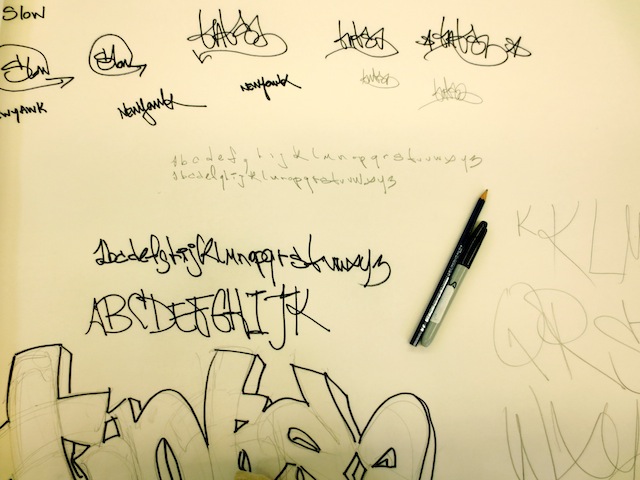
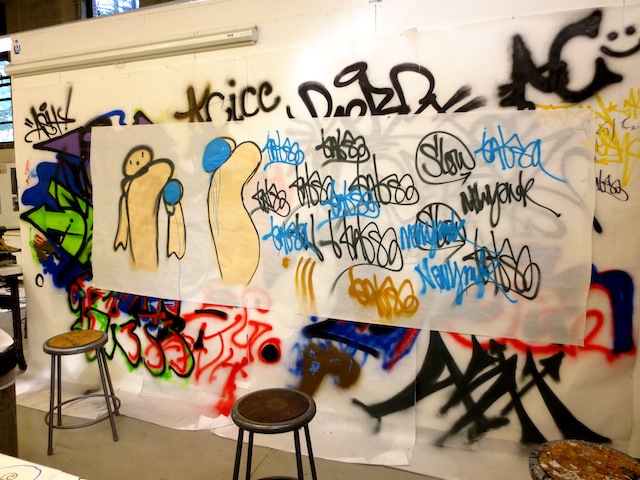
Chris Stain & Cake were our second and third guest artists. Chris gave a detailed presentation on his past and current works, as well as the history of stencil art making. He gave a demonstration on how to cut stencils from scratch. Chris placed several examples in and around the studio, we are still discovering some of the well-hidden surprises.



In the immediacy of having several artists together in the same space, Chris, Cake and I got up on this collaborative piece, three artists with three different styles resulting in one rare new work of art. We later discussed the importance of artistic styles and collaboration in general.

Chris Stain’s sent this statement in about the class:
“What I enjoy about the class is being able to share my experience with people who are interested in doing something creative. Creativity, seems to me, to be the key for moving forward in life. No matter what people are involved in, be it business, construction, teaching, etc being creative can get one out of the “box” of the normal way of thinking and breaking routine thought patterns making room for new ideas. I think that’s important because you can only get so far following the pack, you can only be taken to the place that someone else wants to go. But the question comes up ” where do I want to go?” Offering individuals a credited class about graffiti and street art allows for an adventure in creativity and helps build confidence on a very DIY level where the intimidation one might feel in a life drawing class to be as good as Da Vinci is simply not present or necessary.”
Cake gave a presentation on her work as well as a wheat paste demonstration for interior and exterior application. She left her mark both inside and outside of the printmaking studio.



Cake sent in this statement about the class:
“Ryan’s class delivers the joy and freedom that pure expression creates and that is inherent in street art and graffiti. I walked into the class that day and saw the students engrossed in creating a stencil under the guidance of Chris Stain and I could feel in them the excitement that discovering new ways of expression can produce. Sharing my work with the class provided me with nothing short of pure joy in the same way making the work for the streets does. I think Ryan’s class succeeds in creating inspiration in a way that is a service to any person who has that innate desire to create inside of them. I’m grateful that Ryan’s class exists to help keep this movement afloat and I’m grateful I was given the opportunity to give a little something back to a movement that has given me more than I can articulate. For me, Street Art is magic because it brings many forms of connection to the table for anyone who chooses to accept it and ultimately, it connects me to the world I’m living in, reminding me that in this life I have something to give, and something to receive.”

For day 3, we met up in NYC for a walking tour down town with Gabe Schoenberg. Gabe was our fourth guest artist and is the owner operator of Graffiti Tours NYC. The tour provoked the students to engage with the actual art in the space that it was created in. This provoked a whole new series of dialogs that transcended our classroom and studio setting. As the grand finale of the walking tour the class was lucky to experience the large piece down on Houston Street and Bowery. The space changes every four months or so, but this particular piece by Revok and Pose covers a great deal of dedications to many of the graffiti writers we have been talking about in the course.



On H.Veng Smith was our fifth guest artist. Veng presented a great juxtaposition of his works, and how he simultaneously transitions between painting large-scale all aerosol based murals with his collective Robots Will Kill to smaller scale realistic oil paintings of birds, portraits, and other forms of nature. Veng gave the class another aerosol technique demonstration on how to build up values and layers with the can. The end result, one of his infamous eye pieces. Veng then proceeded to start the class off on a collaborative mural.
On the last day of our course before our final two guest artists, I gave the class a presentation about my own work. I spoke about where it started and where it has transcended to as both an art educator and an evolving working artist. I spoke a bit about the ego aspect of my earlier years writing graffiti and making the transition from creating non-commissioned illegal works to seeking out permission based projects to create community, awareness, and commissioned works.
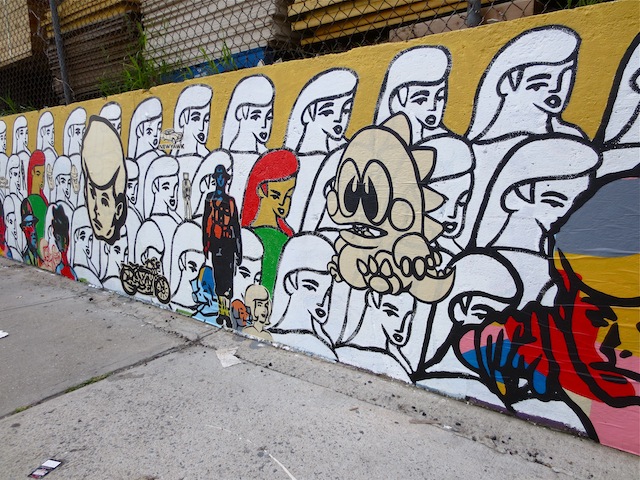
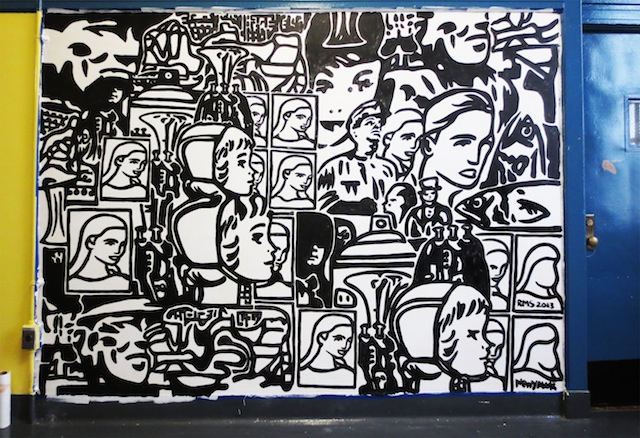
Leon Reid IV & John Fekner were our sixth and seventh guest artists. This was the final day of the course. Leon Reid IV gave a presentation and shared his story. The lecture was funny and insightful. The class was inspired by his use of three-dimensional objects, as well as his clever use of contexts and humor. Leon proceeded to lead the class in an exercise that deals with the creation of art in public space. By handing the students 4 images of 4 different types of public spaces, and then asking them to generate a concept or idea based sketch for a piece of art that would best function in that space. Students are asked to draw directly onto the images. A formal critique and dialog then took place where the ideas and concepts were discussed. Students were forced to be immediate and intuitive while also displaying their retention of what they experienced during the first 4 days of our class.
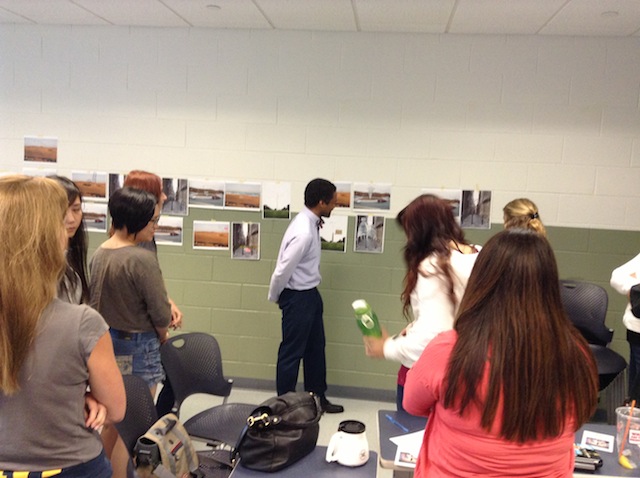
Leon Reid sent in the following statement about the course:
“Ryan Seslow’s course at LIU Post on the history of graffiti and street art is a giant leap forward for our genre; I’m not aware of any other professor nor any university that offers credits for a class on such a controversial art form. My presentation was welcomed with enthusiasm and participation from the students. If more universities offered a course like this I believe there would be greater understanding for this global movement.”
John Fekner was our last guest artists and speaker. From a video chat via Skype, John shared with us a multitude of his wisdom. From graffiti to street art to public art, to community building and over all inspiration. The class learned about his process and how his early works took shape. We spoke about the south Bronx in the late 1970’s and how public art can raise the over all awareness of an entire community.
John Fekner sent in the following statement about the course:
“A shared studio space is an active learning environment. More than ever, having a ‘place’ other than the comfort and security of home or the stability of the work environment, is not only a crucial component for an artist’s development, but essential for anyone pursuing an education today. By combining the input and contribution of other artists, musicians, poets, etc., with one’s own creative development and experimentation, a unique synergistic expression of art evolves for the common good for everyone. It may be an intensive graduate workshop at a university with contributions from teachers, mentors and students from different backgrounds and cultures; or a neighborhood mural project where an artistic teams interact and connect with a diverse mix of local residents who live and work and enjoy the outdoor art on a daily basis. The end result is art for everyone – anytime, without a fee.”
In conclusion as I reflect back on the last 4 years creating and teaching this course, I see only huge boosts in overall student interest and participation. They are spreading the word fast, just as I am. My colleagues are catching the fever and inquiring. Enrollment is high and full courses will always induce further support. My students want and need to understand what motivates graffiti and street artists to create the work that they do. I see more and more artists adopting aerosol techniques, stencil techniques and graphic character usage to create new and transcendent works both on and off the streets. Over the next year or so (as it already is in the works) I believe the inevitable will manifest, this course will become a popular regular semester course that continues to develop, expand, and transcend into a serious field of study at the college level. It is one of the first 3 credits courses over the last 4 years to run here in NY, but other colleges and universities are catching on. I am building a network of other academics who are interested in getting involved. Research is underway, as well as micro testing courses like this. The course offers an array of interdisciplinary study on so many levels. We have barely scratched the surface. Street art and graffiti is not slowing down by any means. As a movement in contemporary art it affects our perception in relationship to the awareness we have of public space, and how it now lives and redefines itself both inside and outside of the designated art space simultaneously. Gamers and video artists are interested. As well as how b-boying, hip hop, break dancing and DJ culture synthesizes into the content to play a continued role. It does not stop there by any means. This is an international subject and it breeds a ton of potential for creativity with other cultures. In January of 2015 as a participating artist and the head curator, I will be mounting an all street art and graffiti exhibition at the Hillwood Art Museum. The museum is located on the campus of Long Island Universities Post location in Brookville, NY (about 35 mins from NYC). Over 20 amazing artists, bloggers, and affiliated people are involved. Stay tuned, there is so much more to come.
Special thanks to: H.Veng Smith, SEBS, Chris Stain, Cake, Leon Reid IV, John Fekner, Gabe Schoenberg, the LIU Post Art department for supporting this course, RJ/ Vandalog.com, and all the amazing students who came out to take the course. I am proud to know that your official college transcripts will forever have this course attached to it!
To read more about the course check out this post on ryanseslow.com.
Photos by Ryan Seslow
